The Aging Moon’s Morning Tour of Bright Planets Let’s Us Enjoy June’s Brightest Lights and Boötes’ Bounty!
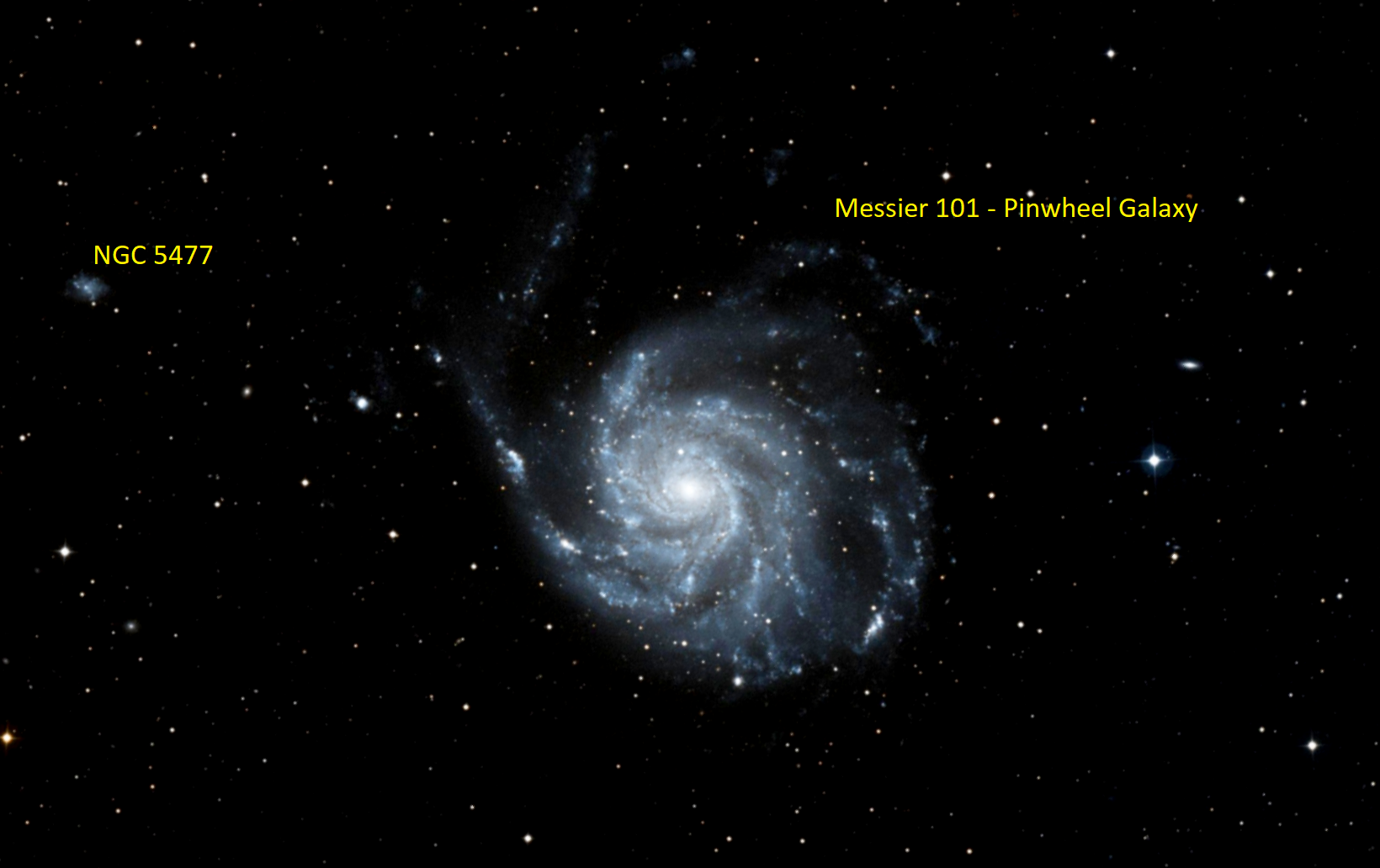
Messier 101 also known as the Pinwheel Galaxy and NGC 5457 is a large, face-on spiral galaxy in Ursa Major near the Big Dipper’s handle tip star, Alkaid. This Sloan digital Sky Survey image spans about 25 arc-minutes top to bottom – or about the diameter of the full moon. In June the galaxy is nearly overhead. It can be seen in binoculars from a dark sky location on a moonless night.
Hello, Pre-summer Stargazers!
Here are your Astronomy Skylights for the week of May 30th, 2021 by Chris Vaughan. Feel free to pass this along to your friends and send me your comments, questions, and suggested topics. I repost these emails with photos at http://astrogeo.ca/skylights/ where the old editions are archived. You can also follow me on Twitter as @astrogeoguy! Unless otherwise noted, all times are expressed in Eastern Time. To subscribe to these emails please click this MailChimp link.
I can bring my Digital Starlab portable inflatable planetarium to your school or other daytime or evening event, or teach a session online. Contact me through AstroGeo.ca, and we’ll tour the Universe, or the Earth’s interior, together!
Because the waning moon will be visiting the gas giant planets between midnight and dawn this week, stargazers around the world will be treated to dark, moonless evening skies – perfect for treasure hunting in Boötes and beyond. Mercury will sink out of view early this week, leaving only very bright Venus and modest Mars after sunset. Read on for your Skylights!
The Moon
This week the moon will be absent from evening skies all over the world – leaving the night sky nice and dark for viewing deep space targets! Our natural satellite will be reducing its angle from the sun – so the moon will be rising between midnight and dawn – and then lingering in the daytime morning sky as an echo of the night.
Tonight (Sunday), the moon won’t rise until after 1:30 am local time. Once it climbs a little higher look for its bright, gibbous phase shining among the modestly bright stars of Capricornus (the Sea-Goat). As a bonus, the moon will be positioned less than a palm’s width below (or 5 degrees to the celestial south of) Saturn! Jupiter will be shining brightly to the pair’s left. By sunrise, the trio will be in the lower part of the southern sky – making a lovely photo opportunity when composed with some interesting foreground scenery.
If Monday morning is cloudy, set the alarm for Tuesday morning. After 24 hours of motion, the waning, half-illuminated moon will then shine a slim palm’s width to the lower right (or 5 degrees to the celestial south) of Jupiter among the stars of Aquarius (the Water-Bearer). The pair will just squeeze into the field of view of binoculars. Somewhat fainter Saturn will be positioned to their right (celestial west) – giving us a second photo opportunity.
The moon will officially reach its third quarter phase at 3:24 am EDT (or 7:24 Greenwich Mean Time) on Wednesday morning. The name for this phase refers not to the moon’s appearance – but to the fact that it has completed three quarters of its orbit around Earth, measuring from the previous new moon. At third quarter our natural satellite always appears half-illuminated, on its western side – towards the morning sun.
From Thursday through Sunday, early birds can enjoy seeing a very pretty, crescent moon shining in the southeastern sky before sunrise.
The Planets
Following Mercury’s caress of Venus on Friday evening, the speedy planet will continue to drop lower while its orbit carries it between Earth and the sun. Although they are no longer telescope-close, you can still use binoculars for a few more days to locate much dimmer Mercury sitting below extremely bright Venus in the west-northwestern sky after sunset. (Please don’t point optical aids in that area of sky until after the sun has completely set.) Tonight (Sunday) Mercury will sit just two finger widths below, and slight to the right of, Venus. By mid-week, Mercury will be a palm’s width below Venus – so it will be all but invisible within the twilight.

Venus will be shining in the western sky as the “evening star” for much of this year. This week the planet will be setting shortly after 10 pm local time. That’s not long after sunset, so it will already be less than a fist’s diameter above the horizon when it pops out of the darkening sky. Venus’ position on far side of the sun from Earth will give it a round, nearly fully illuminated disk in a telescope (although telescope views when planets are so low in the sky are never ideal).
As the sky is darkening (after about 10 pm local time) look a quarter of the way up the west-northwestern sky for the reddish dot of Mars sitting to the lower left (or celestial south) of the almost-as-bright stars Castor and Pollux, the twins of Gemini. Your telescope will show that Mars still has a small, ruddy disk. Start looking at Mars as soon as it pops into view because it will be getting too low to see clearly in a telescope after about 10:30 pm local time. Mars will set in the west just before midnight local time.

Watch for Mars’ night-to-night motion upwards, compared to Castor and Pollux. Check out Castor (the right-hand, more northerly twin) in your telescope, too. It will split into a beautiful double star!
Are you looking forward to seeing Jupiter and Saturn this summer as much as I am? Those two planets will start to rise before midnight after the middle of June! For now, they are visible in the southeastern sky from the wee hours until almost sunrise. This week yellow-tinted, magnitude 0.55 Saturn will rise within the stars of central Capricornus (the Sea-Goat) at around 1 am local time. Last Sunday, Saturn began a retrograde loop that will last until mid-October. You can observe the planet’s westerly motion by noting how Saturn’s distance from the medium-bright star to its left (east) named Theta Capricorni increases each day.
Even a small telescope will show Saturn’s rings and several of its brighter moons – especially its largest moon, Titan! Because Saturn’s axis of rotation is tipped about 27° from vertical (a bit more than Earth’s axis), we can see the top surface of its rings, and its moons can arrange themselves above, below, or to either side of the planet. During this week, Titan will migrate counter-clockwise around Saturn, moving from above (celestial northwest of) Saturn on Monday morning to the lower left (east) of the planet next Sunday. (Remember that your telescope will flip the view around.)
Much brighter (magnitude -2.45) and whiter Jupiter is positioned among the stars of central Aquarius (the Water-Bearer) – about 1.8 fist diameters to Saturn’s lower left (or 18° to the celestial east). With Saturn moving retrograde, the separation between the two planets will increase a little bit every morning – until Jupiter begins its own retrograde loop later this month. This week Jupiter will be rising at about 1:30 am local time. It will be easy to see until almost sunrise.
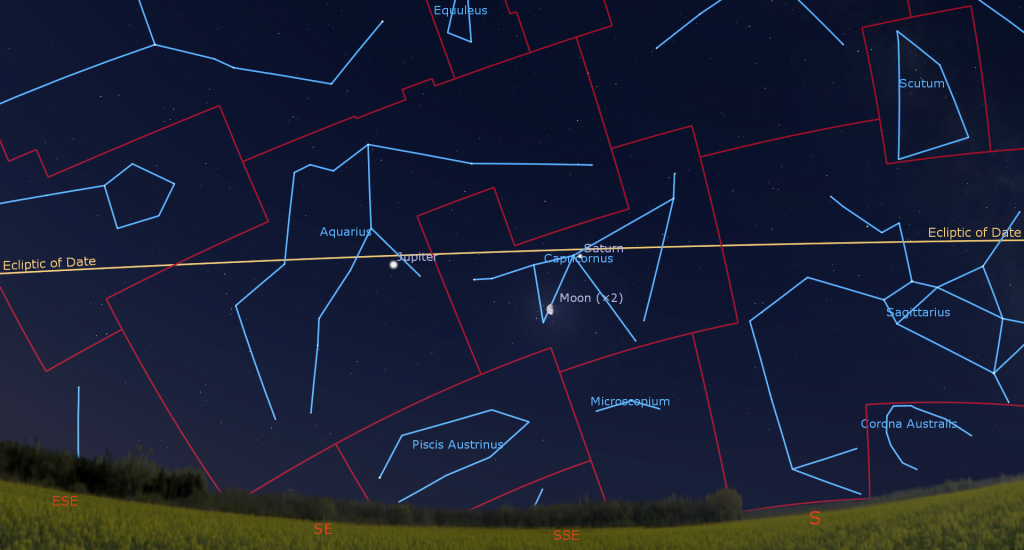
Due to the very low morning ecliptic at this time of year, Jupiter and Saturn don’t climb very high above the horizon, especially for viewers along mid-Northern latitudes. That makes it hard to obtain sharp views of those planets in a telescope. Since the ecliptic is higher for observers at southerly latitudes, both planets will be higher and clearer in telescopes there. If you are willing to get up early and take your backyard telescope outside, the Great Red Spot (or GRS) will be visible crossing Jupiter on Monday, Thursday, and Saturday morning.
On Saturday, June 5, lucky observers across most of Europe and Africa will be treated to a rare treat in the eastern pre-dawn sky! From time to time, the small round black shadows cast by Jupiter’s four Galilean moons become visible in amateur telescopes as they cross (or transit) the planet’s disk. Starting at 2:22 am Eastern European Summer Time (EEST) Io’s smaller shadow will join Ganymede’s larger shadow already making its way across Jupiter’s equatorial region. Because Io orbits closer in to Jupiter, its shadow crosses Jupiter faster – allowing it to catch up to, and then temporarily merge with, Ganymede’s shadow for a few minutes surrounding 3:34 am EEST (or 00:34 GMT). Io’s shadow will then lead Ganymede’s shadow across the rest of Jupiter’s disk until 04:40 am EEST (or 1:40 GMT). Ganymede’s shadow will complete its own passage 40 minutes later.
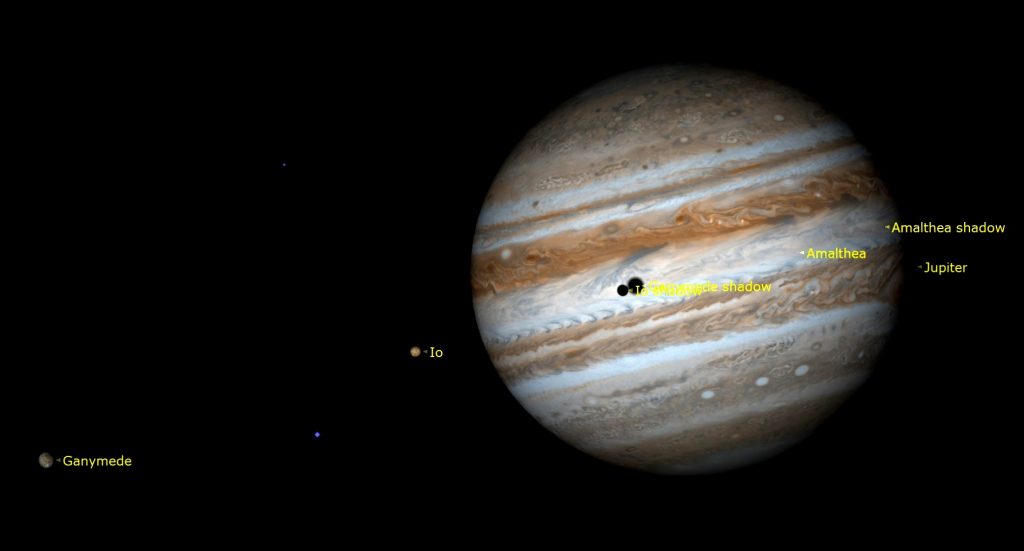
A less exciting shadow transit will occur on Thursday morning, when observers in the Eastern Time zone can watch the single shadow of Io, which will be crossing Jupiter when the planet rises, until 3:10 am EDT.
Next Sunday, the major main belt asteroid designated (3) Juno will reach opposition. At that time, Earth will be passing between Juno and the sun, minimizing our distance from Juno and causing it to appear at its brightest and largest for this year. The magnitude 10.1 asteroid will be visible in backyard telescopes all night long. On opposition night, Juno will be traversing the stars of Ophiuchus (the Serpent-Bearer), and positioned just two finger widths to the left (or 2.5 degrees to the celestial east) of the bright globular star cluster designated Messier 10. On June 17-18 Juno’s westward motion will carry it through that cluster, allowing both objects to appear together in telescopes for several nights!
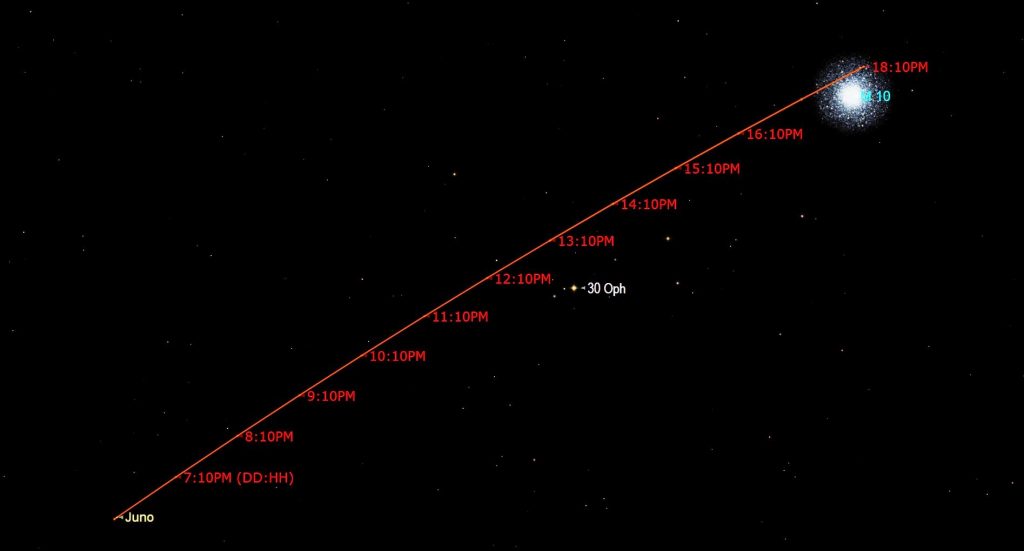
Bright Stars of June
To find your way around the night sky, it helps to get to know the brightest stars. Here’s a tour of the brightest lights on June evenings.
Astronomers use the magnitude scale to indicate brightness of objects. I’ll mention those numbers below – but you don’t need to remember them. The star Vega anchors the scale at magnitude 0.0. Each integer higher reduces the brightness by 2.5 times, and each integer lower increases the brightness by the same factor. Polaris, the North Star, shines at magnitude 1.95, which is 6.3 times fainter than Vega. A magnitude step of 0.5 changes the brightness by about 50%.
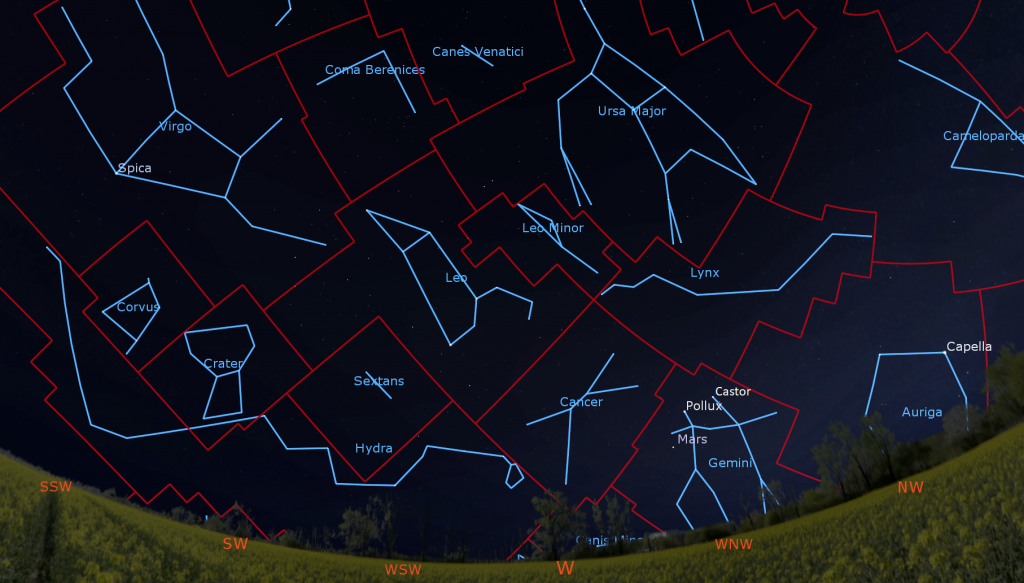
Facing west after sunset, look low in the sky for the bright, yellowish star Capella in Auriga, the Charioteer. Capella shines at magnitude 0.05. A little higher, and to the left (celestial southeast), you’ll find the “twin” stars Castor (on the right) and Pollux (on the left) in Gemini. At magnitude 1.15, Pollux is nearly twice as bright as magnitude 1.9 Castor – and it’s a much warmer white in colour. Let’s call them fraternal twins.
Before turning away, tilt your head back and look nearly overhead for the seven bright stars of the Big Dipper. Those stars all shine at about magnitude 2, but the bowl stars are somewhat fainter than the handle stars. Can you tell?
Next, face southwest and look less than halfway up the sky for two bright white stars. Regulus (magnitude 1.35), the heart of Leo, the Lion, is positioned toward your right. Brighter, magnitude 0.95 Spica, the brightest star in Virgo, the Maiden will be about as high in the sky, but towards your left.
Cast your gaze high in the southern sky to spot yellow-orange Arcturus. You can’t miss it! At magnitude -0.15, it’s not only the brightest star in Boötes (the Herdsman), but also the fourth brightest star in the entire night sky. Only Sirius is brighter for mid-Northern latitude skywatchers. I share more about Arcturus below.

If your southeastern horizon isn’t blocked by trees or buildings, look for very bright and reddish star Antares, the heart of Scorpius, the Scorpion. That magnitude 1.05 star will take centre stage for our Milky Way explorations this summer!
Finally, climbing the northeastern sky is our magnitude scale anchor star Vega, in Lyra (the Harp). Vega is the next brightest star after Arcturus. To Vega’s lower left (or celestial northeast) you’ll find another bright (magnitude 1.25) star named Deneb, the tail of Cygnus, the Swan. Vega and Deneb are the first corners of the Summer Triangle asterism to appear. And that tells us that summer will soon arrive in the Northern hemisphere!
The Best of Boötes
The absent moon for the next two weeks, and the lovely early June nights, will offer a fine opportunity to explore the realm of Boötes (“Bow-OH-tees”), the Herdsman or Plowman.
After it gets dark, face south and look two-thirds of the way up the sky for the very bright, orange-tinted star Arcturus. The fourth brightest star in the entire night sky, and a “neighbour” of ours at only 37 light-years distance, Arcturus means “Guardian of the Bear” in Greek, because it rises after Ursa Major (the Big Bear), which sits to its upper right (celestial west). Arcturus has that colour because it is just passing middle-age for a star, starting on its way towards the red supergiant stage. In Chinese, Arcturus is known as Dà Jiǎo xīng 大角星, “Great Horn Star”, part of the huge Azure Dragon of the East, which stretches from Boötes and Virgo on the west to Scorpius and Sagittarius on the east. The star Antares marks his heart.
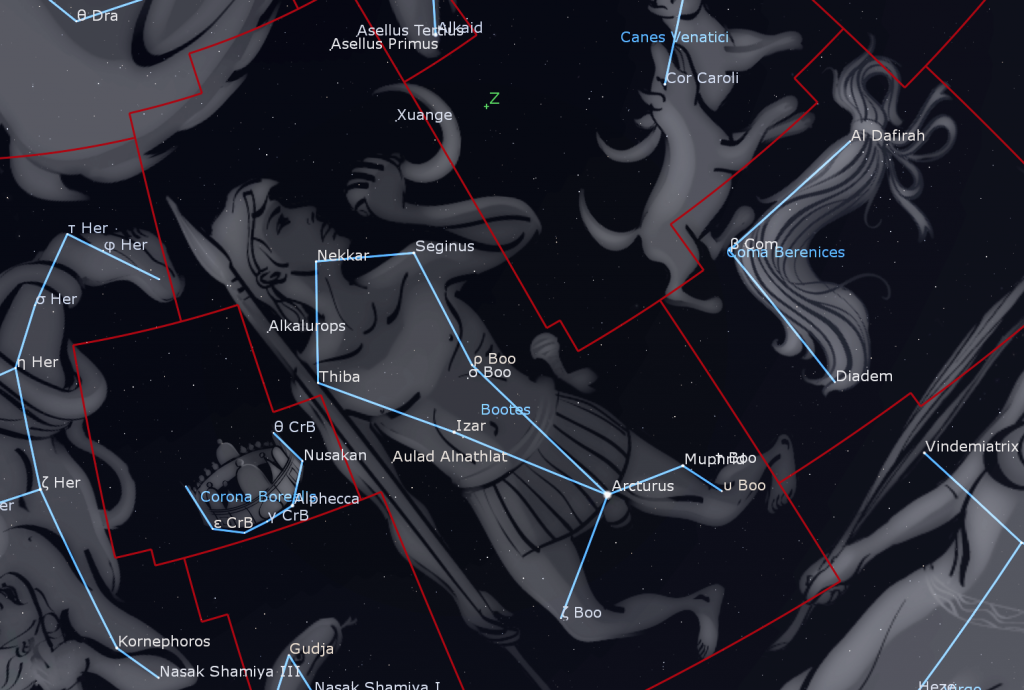
Arcturus sits at the bottom tip of a large, kite-shaped asterism within the larger constellation Boötes. The rest of the stars in the kite are medium-bright and visible under partly light-polluted skies. The kite measures 2.3 fist diameters on the long axis and a fist’s width across its widest point. Boötes stands upright above the ecliptic, higher than Virgo (the Maiden) and below the sinuous dragon, Draco. He is bordered on the left (celestial east) by Hercules and Corona Borealis (the Northern Crown) and by Coma Berenices (Berenice’s Hair) and Canes Venatici (the Hunting Dogs) on the right (celestial west), with Ursa Major’s Big Dipper above them.
Let’s tour Boötes’ stars, moving counter-clockwise from Arcturus. Two easily visible stars are positioned a fist’s diameter to the upper left (or 10° to the celestial northeast) of Arcturus. The brighter one is Izar, meaning “Loin Cloth”. The fainter star, which sits half a finger’s width from Izar, is named 34 Boo. In a telescope, Izar splits into a gorgeous double star – with one partner golden and the other one white, or greenish.
About twice as far from Arcturus along the same line through Izar brings us to the herdsman’s eastern shoulder, a medium-bright star designated Delta Boötis (δ Boo) or Thiba. (The word Boötis is Latin for “belonging to Boötes”.) Thiba is a sun-like star, about ten times more massive than our sun. It is located 117 light-years away from our solar system. A star named Nekkar “Ox Driver” shines a generous palm’s width above (or 7.5° to the celestial northwest) of Thiba. Nekkar marks the herdsman’s head (and the tip of the kite). Nekkar is an elderly blue star passing through a phase that is causing it to temporarily resemble a large version of our sun. But it’s on its way to becoming a brighter, red giant star.
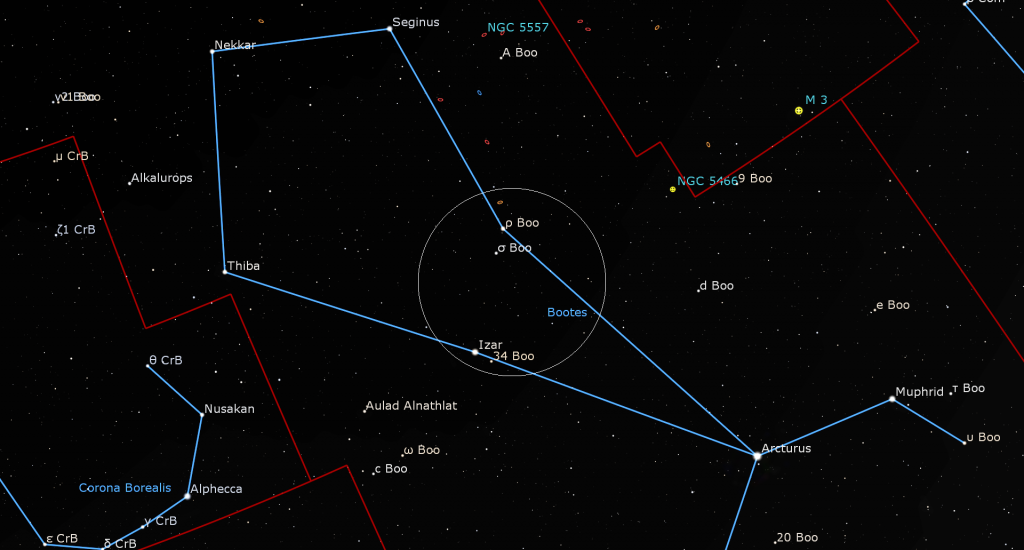
A triple star named Alkalurops, a name derived from “Shepherd’s Staff”, sits about four finger widths to the upper left (or 4.5° to the celestial northeast) of Thiba. It forms a squat triangle with Thiba and Nekkar. Two of Alkalurops’ stars can be discerned with sharp eyes or binoculars, and one of them splits into two stars when viewed through a telescope. All three stars are orbiting one another in a dance that takes at least 125,000 years for one orbit. Position Alkalurops towards the right side of your binoculars’ field of view and look for two side-by-side stars named v1 and v2 Boo on the left. They are different colours!
As we hop to the right from Nekkar and return toward Arcturus down the crooked higher (western) side of the kite, our first stop is a medium-bright star named Seginus, which marks the herdsman’s western shoulder. Seginus is a white giant star that is evolving towards becoming a red giant one day. This 85 light-years distant star is spinning about 70 times faster than our sun!
Halfway between Seginus and Arcturus we find a medium-bright star designated Rho Boötis (ρ Boo). This star, which is opposite to Izar in the kite, marks the herdsman’s western hip. See if you can see a small star sitting just below Rho. That’s Sigma Boötis (σ Boo).
The medium-bright stars positioned to the lower right (celestial south) of Arcturus form the herdsman’s legs and feet. The left (eastern) foot, which sits less than a fist’s diameter below Arcturus, is designated Zeta Boötis (ζ Boo). In a telescope it is revealed to be a nice, matched pair of close-together white stars. Moving about four finger widths along Boötes’ western leg brings us to the bright star Muphrid. It, too has a composition similar to our sun. Even though it is actually as far away from us as Arcturus, its inherent brightness is lower, so it appears much dimmer in the sky. Dropping down slightly and moving farther to the right brings us to Upsilon Boötis (υ Boo), a very distant red giant star.
All the stars within our galaxy are in motion, jostling about as they orbit the galactic centre every quarter of a billion years or so. Some stars move faster, or are located closer to us – so they exhibit a greater apparent motion compared with the surrounding stars. Astronomers call this phenomenon Proper Motion. That’s why star charts need to be updated from time to time. Arcturus has a very high proper motion southward. In a few thousand years, the herdsman’s legs will be bent upwards with Arcturus below his knees!

Boötes’ territory extends almost to the tip of the Big Dipper’s handle. Just before you get there, look for a tight grouping of three stars that represent the herdsman’s upraised hand. The star names are Asellus Primus, Asellus Secundus, and Asellus Tertius “First, second, and Third Donkey”. Two of them are telescopic double stars, and the area around them is a lovely, rich field for viewing – it’s full of small galaxies. The famous and easy-to-see Pinwheel Galaxy (Messier 101) is located only a few finger widths away from them!
Boötes is lacking in deep sky objects. A palm’s width to the right (or 6 degrees to the celestial southwest) of Rho Boötis sits the globular star cluster known as the Snowglobe Cluster (and NGC 5466). It will appear as a small, fuzzy patch in binoculars and backyard telescopes under a dark sky. A further palm’s width to the upper right (or 5° to the celestial west) of the snowglobe, in next-door Canes Venatici (the Hunting Dogs), is the magnificent and much brighter globular cluster named Messier 3 – an easy city object.
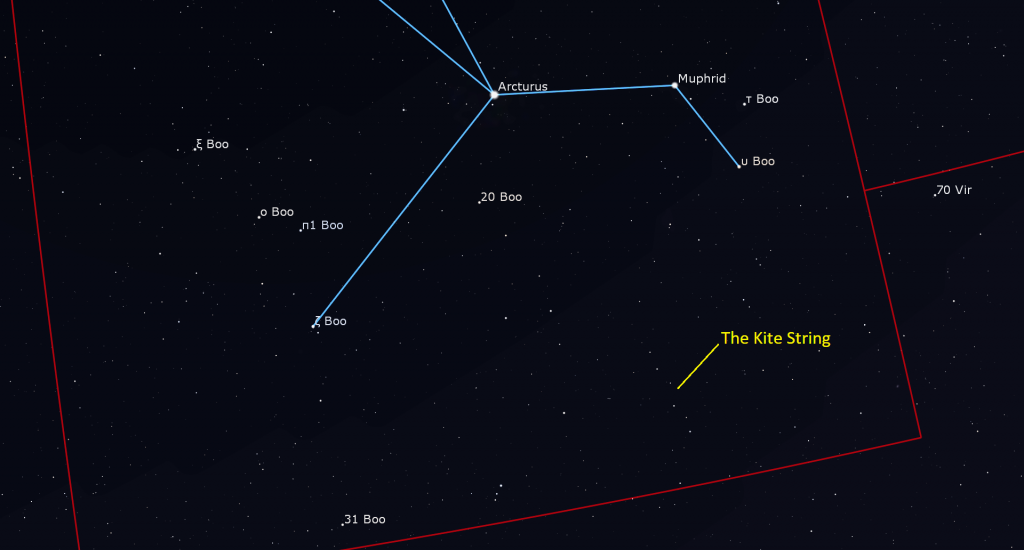
Use your binoculars to seek out a long chain of 6 and 7 magnitude stars located below and between the herdsman’s feet – the kite’s string!
Public Astro-Themed Events
Every Monday evening, York University’s Allan I. Carswell Observatory runs an online star party – broadcasting views from four telescopes/cameras, answering viewer questions, and taking requests! Details are here. Their in-person Wednesday night viewing has been converted to online via the observatory YouTube channel, where they offer free online viewing through their rooftop telescopes, including their 1-metre telescope! Details are here.
On Wednesday evening, June 2 at 7:30 pm EDT, the RASC Toronto Centre will live stream their monthly Recreational Astronomy Night Meeting at https://www.youtube.com/rasctoronto/live. Talks include the Sky This Month (presented by me), landscape astrophotography, and planning for and avoiding asteroid impacts. Details are here.
On Thursday, June 3 at 12 pm EDT, RASC National will continue their weekly moon-observing series the Moon at Noon featuring Jenna Hinds and guests. Details are here and the registration link is here! Sessions are also live-streamed to YouTube here and can be watched at any time.
Public sessions at the David Dunlap Observatory may not be running at the moment, but we are pleased to offer some virtual experiences instead in partnership with Richmond Hill. The modest fee supports RASC’s education and public outreach efforts at DDO. Here are two upcoming events:
On Saturday night, June 5 from 7 to 8:30 pm EDT, DDO Astronomy Speakers Night will feature RASC member Ron MacNaughton speaking on “How Ancients Predicted Eclipses”. Ron will explain why eclipses happen, accurate patterns observed especially by Babylonians, the mathematical model by the Greeks for the motion of bodies around the Earth, and later developments by Kepler, Newton and others which now allow the location of total solar eclipses to be established with great accuracy. We’ll also take a virtual tour of the DDO, and have opportunities to ask them questions. Only one registration per household is required. Deadline to register for this program is Friday June 4, 2021at 3 pm. The registration link is here.
On Sunday afternoon, June 6 from 12:30 to 1 pm EDT, join us for Sunday Sungazing. Safely observe the sun with us, from the comfort of your home! During these family-friendly sessions, a DDO Astronomer will answer your questions about our closest star: the sun! Learn how the sun works and how it affects our home planet. Live-streamed views of the sun through small telescopes will be included, weather permitting. Only one registration per household is required. Deadline to register for this program is June 4, 2021 at 3 p.m. Prior to the start of the program you will be emailed information on the virtual program links and any specific information relating to your program. The registration link is here.
My free, family-friendly Insider’s Guide to the Galaxy webcasts with Jenna Hinds of RASC National will return in July with a Summer Planets Spectacular! You can find more details, and the schedule of future sessions, here and here.
Keep looking up, and enjoy the sky when you do. I love questions and requests. Send me some!